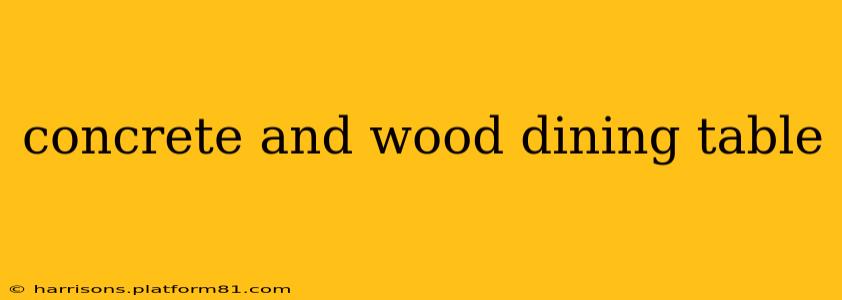Concrete and wood dining tables have surged in popularity, offering a unique blend of industrial strength and natural warmth. This captivating combination creates a focal point in any dining space, seamlessly blending rustic charm with modern aesthetics. This guide delves into the appeal of these tables, explores their various styles, and answers common questions to help you choose the perfect one for your home.
Why Choose a Concrete and Wood Dining Table?
The allure of a concrete and wood dining table lies in its inherent duality. The robust concrete base provides a solid, long-lasting foundation, often showcasing a sleek, minimalist design. This contrasts beautifully with the organic textures and warmth of the wood tabletop, adding a touch of natural beauty and inviting comfort. This fusion of materials creates a visually striking piece that's both modern and inviting, suitable for a wide range of interior design styles, from industrial lofts to rustic farmhouses.
The combination also offers practical advantages. Concrete is exceptionally durable and heat-resistant, making it ideal for placing hot dishes directly on the surface (though a coaster is always recommended!). Wood, meanwhile, adds a touch of elegance and can be chosen in various finishes and stains to complement your existing décor.
What are the Different Styles of Concrete and Wood Dining Tables?
The beauty of concrete and wood dining tables lies in their versatility. Styles range from minimalist and modern to rustic and farmhouse chic.
Modern Minimalist:
These tables often feature a clean, simple concrete base with a sleek, rectangular or square wooden top. The wood is typically light in color, emphasizing the contrast with the dark gray or polished concrete.
Rustic Farmhouse:
These designs incorporate thicker, more textured wood tops, possibly with live edges or a distressed finish. The concrete base might have a more raw, unfinished look, emphasizing the natural feel.
Industrial Chic:
These tables often feature exposed concrete legs or a metal frame combined with a reclaimed wood top, creating a rugged and sophisticated look.
Mid-Century Modern:
This style blends the clean lines of mid-century design with the contrasting materials. You might see tapered concrete legs supporting a richly stained, mid-tone wood tabletop.
What Kind of Wood is Best for a Concrete and Wood Dining Table?
The choice of wood significantly impacts the overall aesthetic and durability of the table. Popular choices include:
- Oak: Known for its strength and beautiful grain, oak offers a classic and timeless look.
- Walnut: Rich in color and texture, walnut adds a luxurious touch to any dining space.
- Maple: A lighter-colored wood, maple provides a clean and contemporary feel.
- Reclaimed Wood: Using reclaimed wood adds character and sustainability to the piece.
How Much Does a Concrete and Wood Dining Table Cost?
The price of a concrete and wood dining table varies significantly depending on the size, materials used, and craftsmanship. Expect to pay anywhere from a few hundred dollars for a smaller, simpler table to several thousand for a custom-made piece with high-end materials.
How Do I Care for a Concrete and Wood Dining Table?
Caring for your concrete and wood dining table requires a bit of attention to both materials. For the concrete base, a damp cloth is usually sufficient for cleaning. Avoid abrasive cleaners. For the wooden top, use appropriate wood cleaner and conditioner as needed to maintain its beauty and prevent drying. Always use coasters to protect the surface from heat and water damage.
What are the Pros and Cons of a Concrete and Wood Dining Table?
Pros:
- Durability: Both concrete and wood are long-lasting materials.
- Unique Style: The combination creates a striking and memorable piece of furniture.
- Versatile: Suits a variety of interior design styles.
- Heat Resistant (Concrete): The concrete base can withstand hot dishes.
Cons:
- Weight: Concrete tables are heavy and may be difficult to move.
- Cost: Can be more expensive than traditional dining tables.
- Maintenance: Requires some care to maintain both the concrete and wood surfaces.
Is a concrete and wood dining table easy to clean?
Yes and no. The concrete base is incredibly easy to clean; a damp cloth will generally suffice. The wooden top requires a little more care; avoid harsh chemicals and use a suitable wood cleaner to maintain its finish and prevent damage.
Are concrete and wood dining tables heavy?
Yes, they are considerably heavier than tables made entirely of wood or lighter materials due to the weight of the concrete base. This should be considered when moving or placing the table.
This guide provides a comprehensive overview of concrete and wood dining tables. Remember to carefully consider your style, budget, and space when making your choice. With proper care and maintenance, your concrete and wood dining table will be a beautiful and functional centerpiece in your home for years to come.
